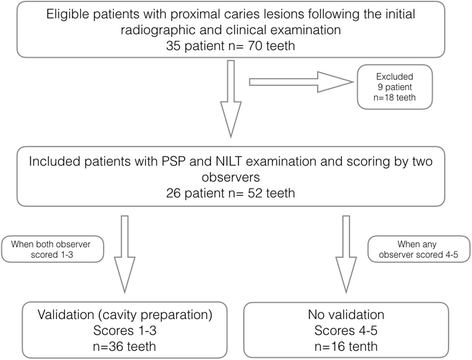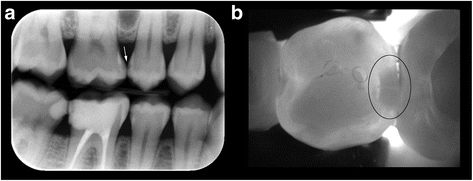Comparison of diagnostic methods for early interproximal caries detection with near-infrared light transillumination: an in vivo study
- PMID: 29145846
- PMCID: PMC5689175
- DOI: 10.1186/s12903-017-0421-2
Comparison of diagnostic methods for early interproximal caries detection with near-infrared light transillumination: an in vivo study
Abstract
Background: Although numerous studies have used digital intraoral imaging, only a few studies have used photo-optical methods for the diagnosis of caries. Moreover, several limitations exist in terms of observers (experience and specialty) and the caries lesion itself. Hence, the aims of this study were to evaluate the diagnostic capability of near-infrared light transillumination (NILT) and PSP-Bitewing radiographs and to compare the interobserver and intraobserver differences in addition to observers' experience level to detect early interproximal caries lesions in vivo.
Methods: A total of 52 untreated posterior teeth with and without varying degrees of early interproximal carious lesions were included. Bitewing radiographs using digital phosphor plates (PSP-Bitewing) and NILT were used to clarify the diagnosis. An oral and maxillofacial radiologist and a restorative dentistry consultant evaluated the images twice. A separate appointment for clinical validation and restoration was made. Kappa coefficients were calculated to assess both intraobserver and interobserver agreements for each evaluation method. Scores obtained from PSP-Bitewing and NILT were compared with the clinical validation via receiver operating characteristic (ROC) analysis.
Results: No significant differences were found between PSP-Bitewing radiography and NILT for detecting early interproximal carious lesions with high average Az results. Both intraobserver and interobserver agreement values were relatively higher for NILT evaluation. The Az values increased at second evaluations for both caries detection methods.
Conclusions: NILT examination has an appropriate sensitivity and diagnostic accuracy for detecting early interproximal caries lesions and can be considered as a method of choice for detecting caries without the use of ionizing radiation.
Keywords: Approximal caries; Bitewing radiography; Nilt; Photostimulating phosphor.
Conflict of interest statement
Ethics approval and consent to participate
Ankara University Faculty of Dentistry, Ethics Committee, No: 10/7, 2016. Written consent obtained from all patients.
Consent for publication
Not applicable.
Competing interests
The authors declare that they have no competing interests.
Publisher’s Note
Springer Nature remains neutral with regard to jurisdictional claims in published maps and institutional affiliations.
Figures


Comment in
-
Insufficient evidence of the superiority of near-infrared light transillumination over bite-wing digital radiograph for detecting early interproximal carious lesions.J Am Dent Assoc. 2018 May;149(5):e84. doi: 10.1016/j.adaj.2018.01.009. Epub 2018 Feb 13. J Am Dent Assoc. 2018. PMID: 29452648 No abstract available.
Similar articles
-
In vitro performance of near infrared light transillumination at 780-nm and digital radiography for detection of non-cavitated approximal caries.J Dent. 2017 Aug;63:44-50. doi: 10.1016/j.jdent.2017.05.018. Epub 2017 May 27. J Dent. 2017. PMID: 28559050
-
Accuracy of near-infrared light transillumination (NILT) compared to bitewing radiograph for detection of interproximal caries in the permanent dentition: A systematic review and meta-analysis.J Dent. 2020 Jul;98:103351. doi: 10.1016/j.jdent.2020.103351. Epub 2020 May 5. J Dent. 2020. PMID: 32380136
-
In vivo correlation of near-infrared transillumination and visual inspection with bitewing radiography for the detection of interproximal caries in permanent and primary teeth.Eur Arch Paediatr Dent. 2020 Aug;21(4):509-518. doi: 10.1007/s40368-020-00538-6. Epub 2020 Jun 9. Eur Arch Paediatr Dent. 2020. PMID: 32519275
-
Combined Near-Infrarred Light Transillumination and Direct Digital Radiography Increases Diagnostic In Approximal Caries.Sci Rep. 2019 Oct 2;9(1):14224. doi: 10.1038/s41598-019-50850-5. Sci Rep. 2019. PMID: 31578410 Free PMC article. Clinical Trial.
-
Application of Near-infrared Light Transillumination in Restorative Dentistry: A Review.J Contemp Dent Pract. 2021 Nov 1;22(11):1355-1361. J Contemp Dent Pract. 2021. PMID: 35343464 Review.
Cited by
-
In vitro validation of near-infrared transillumination at 780 nm for the detection of caries on proximal surfaces.Clin Oral Investig. 2019 Nov;23(11):3933-3940. doi: 10.1007/s00784-019-02824-0. Epub 2019 Jan 28. Clin Oral Investig. 2019. PMID: 30693402
-
Caries Lesion Assessment Using 3D Virtual Models by Examiners with Different Degrees of Clinical Experience.Medicina (Kaunas). 2023 Dec 13;59(12):2157. doi: 10.3390/medicina59122157. Medicina (Kaunas). 2023. PMID: 38138260 Free PMC article.
-
Transillumination and optical coherence tomography for the detection and diagnosis of enamel caries.Cochrane Database Syst Rev. 2021 Jan 27;1(1):CD013855. doi: 10.1002/14651858.CD013855. Cochrane Database Syst Rev. 2021. PMID: 33502759 Free PMC article.
-
Comparative Diagnostic Accuracy of VistaCam IX Proxi and Bitewing Radiography for Detection of Interproximal Caries.J Dent (Shiraz). 2023 Dec 1;24(4):395-403. doi: 10.30476/dentjods.2022.95326.1860. eCollection 2023 Dec. J Dent (Shiraz). 2023. PMID: 38149228 Free PMC article.
-
Accuracy of high definition near infrared transillumination camera in detection of hidden proximal caries.J Clin Exp Dent. 2023 Jan 1;15(1):e1-e8. doi: 10.4317/jced.59413. eCollection 2023 Jan. J Clin Exp Dent. 2023. PMID: 36755680 Free PMC article.
References
-
- Jeon RJ, Matvienko A, Mandelis A, Abrams SH, Amaechi BT, Kulkarni G. Interproximal dental caries detection using Photothermal radiometry (PTR) and modulated luminescence (LUM) Eur Phys J Special Topics. 2008;153:467–469. doi: 10.1140/epjst/e2008-00486-4. - DOI
Publication types
MeSH terms
LinkOut - more resources
Full Text Sources
Other Literature Sources
Medical
Miscellaneous

